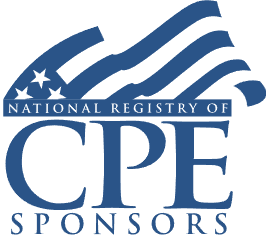Determining Basis for Partners and Shareholders: AAA vs. Capital Accounts, Debt-Financed Losses, Loans and Guarantees

Course Details
- smart_display Format
On-Demand
- signal_cellular_alt Difficulty Level
Intermediate
- work Practice Area
Tax Preparer
- event Date
Friday, January 5, 2024
- schedule Time
1:00 p.m. ET./10:00 a.m. PT
- timer Program Length
110 minutes
-
BARBRI is a NASBA CPE sponsor and this 110-minute webinar is accredited for 2.0 CPE credits.
-
BARBRI is an IRS-approved continuing education provider offering certified courses for Enrolled Agents (EA) and Tax Return Preparers (RTRP).
This course will explain basis calculations for S corporations and partnerships. Our panel of tax professionals will compare and contrast debt-financed losses, AAA (accumulated adjustment account) and capital accounts, and basis restoration. The panel will provide examples of these complex calculations for tax practitioners working with flow-through entities.
Faculty

Mr. Alfonsi has 25 years of tax consulting, business valuation, litigation support and forensic accounting experience. In the tax planning and consulting arena, he works primarily with partnerships and with private equity, venture capital and hedge funds.

Mr. Surkin is an attorney engaged in private practice in the New York metropolitan area. He recently retired from the position of Tax Director at a regional CPA firm based in New York City. Prior to that, Mr. Surkin was a partner at Surkin & Handlin, a boutique firm that handled real estate and tax matters. He is a tax attorney with broad-based experience in tax planning and research, has litigated major cases in the fields of taxation, probate and general commercial matters, and has been peer-reviewed by Martindale-Hubbell. Mr. Surkin holds the highest rating for legal ability and ethical standards, AV. His published articles on tax law have appeared in peer-reviewed journals, practitioners’ journals, and the popular press. Mr. Surkin also writes science-fiction short stories about the adventures of his granddaughters and their dog visiting historic events in their uncle’s time machine (their uncle is also a dog) and serves on the Board of Directors of the Westchester Community Orchestra.
Description
Basis in a flow-through business is key to deducting losses and calculating gains or losses on disposition. Certain losses deductible by partners in partnerships are not deductible by S corporation shareholders. Entity-level debt and personal guarantees are treated differently for these otherwise similar entities.
Shareholders track their basis using accumulated adjustment accounts, while partners use capital accounts. Both are increased by flow-through income and contributions of cash or property and reduced by distributions and deductions. Similarly, both owners are also subject to at-risk rules before loss deductions are allowed.
Planning techniques are available to increase basis in these flow-through entities to deduct current year losses. Ordering rules for loss deductions and restoration of basis are complex. Tax practitioners need to understand the similarities and differences in basis calculations for owners of both partnerships and S corporations to report annual flow-through income and deductions and ultimately the gain or loss on the disposition of these entities.
Listen as our panel of flow-through tax experts discusses how basis is calculated for partnerships and S corporations, planning techniques to increase basis and deductions for losses when and if they occur, and recent cases challenging basis calculations for flow-through entities.
Outline
- Basis overview
- AAA vs. capital accounts
- Annual operating increases and decreases to basis
- Notes payable and guarantees
- Loans from owners
- Debt-financed losses
- Distributions
- Basis restoration
- Planning techniques
- Recent cases
Benefits
The panel will cover these and other critical issues:
- Ordering rules for deducting losses from flow-through entities
- Caveats of decreases in debt basis
- Differences in entity-level debt and basis computations for LLCs and S corporations
- Strategies to increase basis for allowable losses
- How shareholder and partner loans, guarantees, and repayments impact basis calculations
NASBA Details
Learning Objectives
After completing this course, you will be able to:
- Understand the ordering rules for deducting losses from pass-through entities
- Differentiate entity-level debt and basis computations between partnerships and S corporations
- Identify strategies to increase basis for allowable losses
- Determine how shareholder and partner loans, guarantees, and repayments impact basis calculations
- Verify whether inside or outside basis is at issue
- Recognize the impact of the different ordering rules
- Field of Study: Taxes
- Level of Knowledge: Intermediate
- Advance Preparation: None
- Teaching Method: Seminar/Lecture
- Delivery Method: Group-Internet (via computer)
- Attendance Monitoring Method: Attendance is monitored electronically via a participant's PIN and through a series of attendance verification prompts displayed throughout the program
- Prerequisite: Three years+ business or public firm experience preparing complex tax forms and schedules, supervising other preparers or accountants. Specific knowledge and understanding of pass-through taxation, including taxation of partnerships, S corporations and their respective partners and shareholders.

Strafford Publications, Inc. is registered with the National Association of State Boards of Accountancy (NASBA) as a sponsor of continuing professional education on the National Registry of CPE Sponsors. State boards of Accountancy have final authority on the acceptance of individual courses for CPE Credits. Complaints regarding registered sponsons may be submitted to NASBA through its website: www.nasbaregistry.org.

Strafford is an IRS-approved continuing education provider offering certified courses for Enrolled Agents (EA) and Tax Return Preparers (RTRP).
Related Courses

Family Partnerships: Navigating the Discounting Rules for Family-Controlled Entities
Thursday, March 6, 2025
1:00 p.m. ET./10:00 a.m. PT

Form 1041 Schedule D: Reporting Capital Gains for Trusts and Estates
Available On-Demand

Closer Connection Exception: Determining Tax Home; Treaty Tie-Breakers, Form 8840
Thursday, April 10, 2025
1:00 PM E.T.
Recommended Resources
How CPE Can Bridge the Gap Between What You Know and What You Need to Know
- Career Advancement